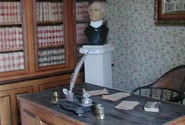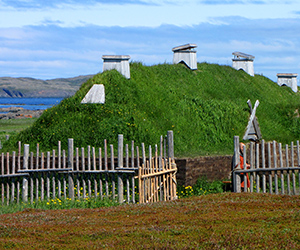CANADA HISTORY - Places-Homes
Musee Laurier

The Musée Laurier, located in Victoriaville, Quebec, stands as an enduring monument to Sir Wilfrid Laurier, Canada’s seventh and first French Canadian Prime Minister. The house, built in 1876 and home to Laurier and his wife, Zoé, until 1897, offers a glimpse into the personal life of one of Canada’s most significant political figures. In 1928, the house was transformed into a museum by two businessmen who purchased the property and donated it to the Quebec government with the condition that it be turned into a museum commemorating Laurier. Over the decades, the Musée Laurier has grown in importance, reflecting not only the life of Laurier but also the historical evolution of Canada during a period of remarkable growth. Designated a provincial historic site in 1989 and a national historic site in 2000, the house remains a well-preserved example of Victorian architecture and interior design in eastern Canada, and it continues to draw visitors interested in Laurier’s legacy and the era he shaped.
Origins of the Laurier House and its Historical Context
Wilfrid Laurier was born in 1841 in Saint-Lin, Quebec, and rose to prominence as a lawyer and politician. By the 1870s, Laurier had established himself as a rising star in Canadian politics, and in 1876, he and his wife Zoé Lafontaine commissioned the construction of a house in the town of Victoriaville. The house, an elegant reflection of Victorian architectural trends, became their primary residence, and it was here that Laurier honed his political philosophy, engaging in discussions that would shape the future of the country.
During the time that Laurier and his wife lived in this house, the political landscape in Canada was undergoing significant changes. The Conservative Party, led by Sir John A. Macdonald, had dominated Canadian politics since Confederation in 1867, but by the mid-1890s, there was a growing appetite for change. Laurier, leader of the Liberal Party, presented himself as a progressive force, advocating for national unity between English and French Canadians and championing free trade and economic expansion.
Laurier’s victory in the 1896 federal election marked the beginning of a new era in Canadian politics. As Prime Minister from 1896 to 1911, Laurier oversaw a period of unprecedented growth, immigration, and industrialization. His government expanded the country’s infrastructure, promoted settlement in the western provinces, and strengthened Canada’s ties to both Britain and the United States. Throughout his tenure, Laurier skillfully navigated the complex linguistic and cultural divides in Canada, becoming known for his moderate and conciliatory approach.
The Creation of the Musée Laurier
After Laurier’s death in 1919, his legacy remained strong, particularly in Quebec, where he was revered as a champion of French Canadian interests and a symbol of national unity. In 1928, two businessmen, recognizing the historical significance of Laurier’s residence in Victoriaville, purchased the house with the intent of preserving it as a memorial to Laurier’s life and career. They donated the house to the Quebec government, on the condition that it be converted into a museum.
The Musée Laurier was established that same year, becoming one of the earliest examples of a Canadian political leader’s residence being turned into a public museum. The creation of the museum was not only a tribute to Laurier but also a reflection of the growing interest in preserving Canada’s political heritage. The museum was meant to serve as a place where Canadians could learn about Laurier’s contributions to the country and gain insight into the political and social context of his time.
Laurier’s Role as Prime Minister
Wilfrid Laurier’s tenure as Prime Minister from 1896 to 1911 was a transformative period in Canadian history. His government focused on expanding the country’s economy through immigration and development, particularly in the western provinces. Laurier’s policies encouraged settlers to move to Manitoba, Saskatchewan, and Alberta, helping to turn the Canadian Prairies into a major agricultural hub.
One of Laurier’s most significant achievements was his ability to bridge the linguistic and cultural divide between French and English Canadians. As a French-speaking Catholic from Quebec, Laurier understood the importance of national unity, and he worked tirelessly to ensure that the interests of both linguistic communities were represented in his government. His moderate approach to issues such as language rights, education, and relations with the British Empire helped maintain stability during a time of rapid change.
Laurier also played a key role in strengthening Canada’s position on the world stage. He was a staunch advocate for Canada’s autonomy within the British Empire, and he worked to ensure that Canada had a voice in imperial affairs. While maintaining close ties with Britain, Laurier also sought to expand Canada’s economic and political relationships with the United States, advocating for closer trade relations between the two countries.
Despite his successes, Laurier’s political career came to an end in 1911, when his government was defeated in a federal election over the issue of free trade with the United States. Although Laurier remained an influential figure within the Liberal Party, his defeat marked the end of his time as Prime Minister.
The House as a National and Provincial Historic Site
The importance of Laurier’s house in Victoriaville lies not only in its connection to Canada’s first French Canadian Prime Minister but also in its architectural and cultural significance. Built in the Victorian style, the house reflects the tastes and values of the late 19th century. Its design, featuring elaborate woodwork, high ceilings, and period furnishings, offers visitors a glimpse into the lifestyle of the Canadian elite during Laurier’s time.
The house remained in the Laurier family’s possession until it was converted into a museum in 1928, and many of the furnishings in the home today belonged to Laurier and his wife. The carefully restored interior includes period-appropriate decor, allowing visitors to experience the house much as it would have appeared when the Lauriers lived there. The home’s preservation provides an excellent example of Victorian architecture in eastern Canada, showcasing the craftsmanship and design trends of the era.
In 1989, the house was designated a provincial historic site by the government of Quebec, recognizing its importance to the province’s cultural and political history. This designation helped ensure that the house would be preserved for future generations. In 2000, the house was further honored when it was designated a National Historic Site by the government of Canada, cementing its place as a key piece of the country’s heritage.
The Musée Laurier serves as both a memorial to Wilfrid Laurier’s life and career and a window into the political and cultural history of Canada in the late 19th and early 20th centuries. As Canada’s first French Canadian Prime Minister, Laurier played a pivotal role in shaping the country’s identity, navigating the complex relationships between English and French Canadians while overseeing a period of rapid growth and expansion. His residence in Victoriaville, now preserved as a museum, offers visitors the chance to explore the personal life of one of Canada’s most important political figures and to learn more about the era in which he lived.
The house itself, with its Victorian architecture and period furnishings, provides a tangible connection to Laurier’s time, allowing visitors to step back into the world of Canada’s early political leaders. As both a provincial and national historic site, the Musée Laurier continues to educate and inspire visitors, ensuring that Laurier’s legacy remains an integral part of Canada’s cultural and political history.
Cite Article : Reference: www.canadahistory.com/sections/documents/documents.html
Source: NA



